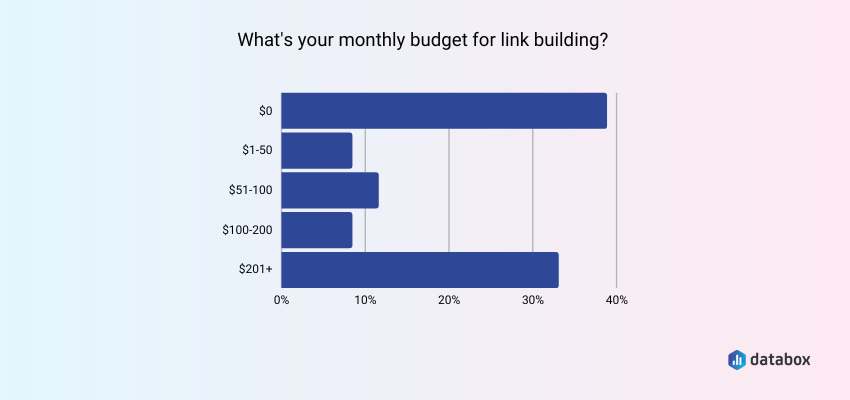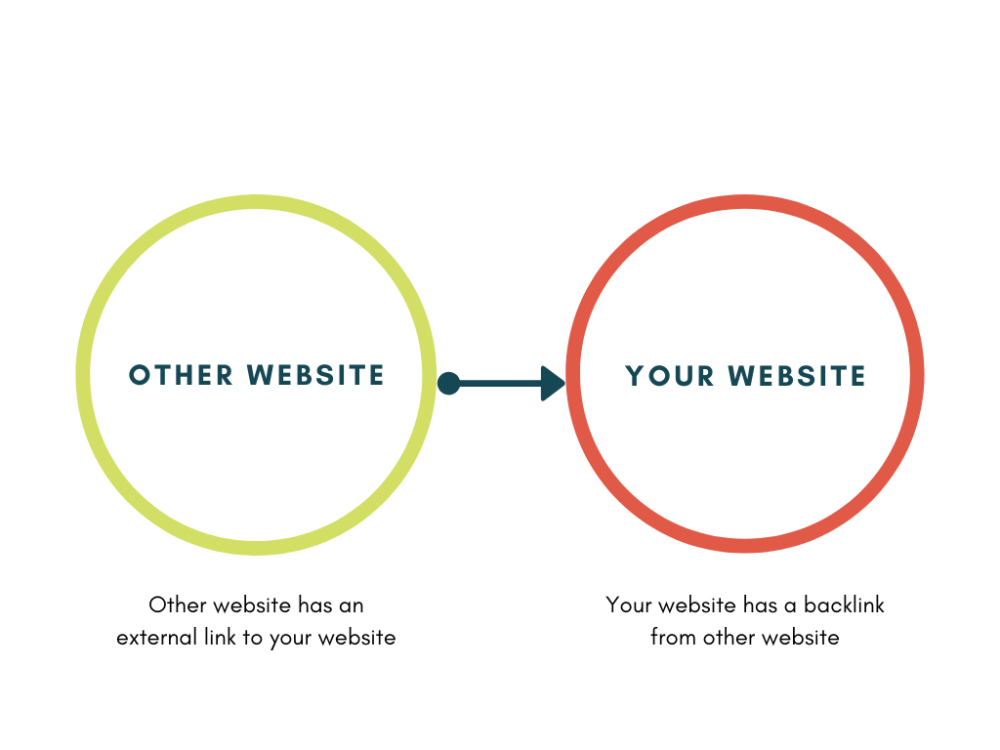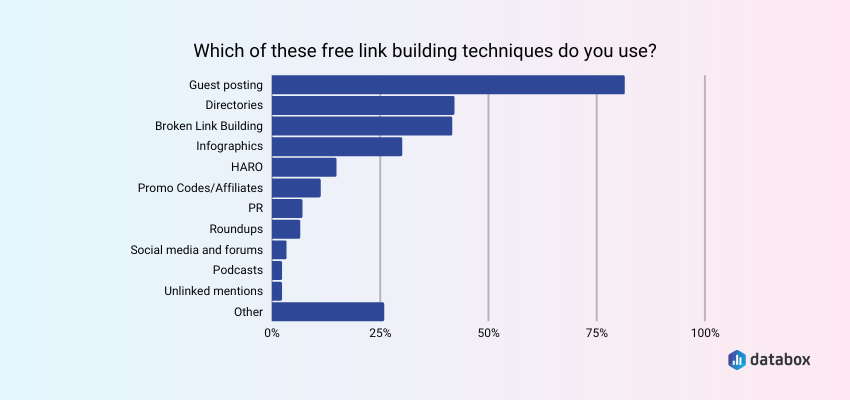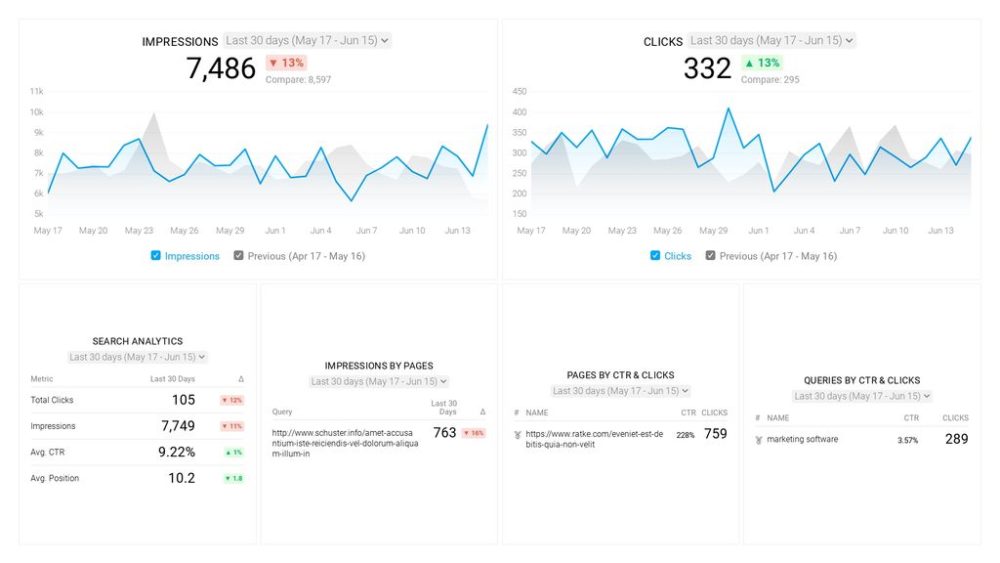Table of contents
With over 1.98 billion websites circulating the internet, it’s no wonder that the vast majority of SERPs have turned into warzones.
And guess who has the biggest guns? That’s right, the companies that are investing millions of dollars into SEO.
To even try to overpower them, you’re going to need a proper SEO strategy in place, and a big part of that strategy revolves around efficient link building.
We know – you can’t compete with the big guys in terms of resources. But if you do it right, you might not have to.
We interviewed almost 200 marketers (191, to be precise) who fought their way onto the top of rankings and, surprisingly, 40% of them said they don’t have any budget for link building, and a further third spend less than $200 per month.

So, if you want to learn how to build free backlinks and outrank your competitors, we compiled a list of some of the most powerful methods you can incorporate – even if your budget is $0.
- What is a Backlink?
- 5 Reasons Why Link Building Is Important
- Not All Links are Equal: Good vs Bad Link Building Practices
- 19 Link Building Tips for Beginners
- 4 Advanced Link Building Tips
- How to Earn Backlinks
- Optimize Your Link Building Strategy with Databox

What Is a Backlink?
Backlinks refer to links created as a result of one website linking to a page on another website. Synonymously, they are also referred to as ‘inbound links’ or ‘incoming links’.

Google and every other major search engine take backlinks into consideration when assessing your website’s importance.
5 Reasons Why Link Building Is Important
Link building is the practice of generating backlinks.
You probably already know that link building is crucial for SEO, but why is that the case? What are the reasons we should participate in link building?
Let’s go through the details.
- Higher Search Rankings (SEO)
- Drive Referral Traffic
- Increase Brand Awareness and Authority
- Build Connections
- Faster Indexing
Higher Search Rankings (SEO)
This is the number one reason why link building is such an important off page SEO strategy. Without backlinks, there’s a really small chance you will rank on Google for competitive keywords.
Google and other search engines consider backlinks to a particular page on your site to be a vote of confidence – that its content is useful and of great relevance. As such, the more backlinks a page tends to have, the higher its search ranking will be.
Backlinks have been Google’s go-to ranking signal for nearly two decades and they still remain the best way to assess webpage quality.
In fact, the #1 Google result has an average of 3.8x more backlinks than results from places #2 – #10.
However, this doesn’t mean that you should just stuff as many backlinks as you can — in fact, these days are long behind us.
Due to updates like Google Penguin, link quality is now Google’s main focus (but more about that later).
Drive Referral Traffic
Backlinks are great for generating referral traffic. When someone clicks on the link that leads to your website from another website, Google recognizes the visitor as a referral, which also doubles as a ranking factor.
The more quality backlinks you have, the more likely you will generate quality referrals and, ultimately, potential customers in the long run.
Increases Brand Awareness and Authority
The more quality backlinks your brand or your SaaS link building agency secures, the better reputation and authority it garnishes.
By providing quality content and getting it linked back to, not only will Google recognize you as an expert in the industry, but so will the readers.
What’s more, new clients will have an easier time establishing trust with your company and your products and services.
Related: 37 Ways High-Ranking Marketers Improve Their Website Domain Authority
Building Connections
In some way, link building is also relationship building. You include backlinks to websites in your industry and vice versa.
Sometimes, companies will offer similar services to yours but recognize you as the “expert” in a specific sub-niche. This helps grow your exposure to other potential prospects.
Having connections in any line of work is never a disadvantage.
Related: A Detailed Guide to Partnership Marketing: Modern Way to Grow Your Business
Faster Indexing
Backlinks help search crawlers discover your website page(s) faster and include it in its databases, making your content more discoverable. This is especially useful for new websites or blogs.
Not All Links are Equal: Good vs. Bad Link Building Practices
It’s a sunny afternoon as you’re walking down the street. Suddenly, just when you’re about to make the next turn, you notice a shady-looking fellow standing on a corner, wearing dark sunglasses and a black hat, offering to sell you some “high-quality backlinks”.
Apparently, this guy has thousands of quality links and will get you to the top SERP results in no time! At a very affordable price!
While you might stop and think, “This is exactly what I need!”, you should avoid acquiring risky links at all costs.
Not only do these links provide practically zero SEO value, they can also lead to Google penalties.
Any kind of attempt to manipulate page rankings is considered a violation of Google’s Webmaster Guidelines.

Source: Linkbuilder.io
To make sure you’re not doing anything “illegal” and stay clear of penalties, here are the bad link-building practices you should avoid:
- Excessive link exchange – You’ve made a connection with another company in your niche and the two of you decided to link to one another. Great! Just make sure you don’t overdo it as it can lead to a drop in rankings.
- Guest posting links with over-optimized anchor texts – Creating links should be a natural process – if it doesn’t make sense from a user standpoint, then you should continue modifying it.
- Adding your site to too many web directories – Do a proper vetting of the web directories to which you plan to add your website. Some of them could be excluded from Google’s search results because they bring zero value to the table. These are the ones you want to avoid. Instead, you should look at directories in your niche that attract your target audience.
- Buying links – This is a direct breach of Google’s guidelines. Google looks at backlinks as votes, so if you’re buying them, it’s not exactly ethical. Aside from needlessly losing money, links coming from PBNs and other types of link farms will get you a Google Penalty once discovered. Instead, focus on creating quality content and promoting it in a way that naturally attracts backlinks.
Any type of link building that involves unethical or illegitimate measures is considered black hat link building, and it will be severely punished by Google.
So, avoid interaction with the shady-looking guy with a black hat, and only follow white hat link building guidelines.
Even though it might take a bit more time to climb the rankings, these tactics are tried and tested, and you don’t risk ruining your site’s reputation (or your own).
PRO TIP: How to Analyze Your Best Pages for SEO Performance
To optimize your website for organic search, you probably use Google Search Console to learn which pages receive the most impressions and clicks, and which queries are driving them. Now you can quickly assess your SEO performance in a single dashboard that monitors fundamental metrics, including:
- Which search queries drive traffic to my website?
- Which of my website pages generate the most impressions and clicks in search engines?
- What’s the average click-through rate (CTR) for our website pages in search?
- What’s the average position our website pages show up in search results?
- How many clicks have our website pages generated in search results this month?
and more…
Now you can benefit from the experience of our Google Search Console experts, who have put together a great Databox template showing the most important KPIs for monitoring organic search performance. It’s simple to implement and start using as a standalone dashboard or in marketing reports!
You can easily set it up in just a few clicks – no coding required.
To set up this Google Search Console Dashboard, follow these 3 simple steps:
Step 1: Get the template
Step 2: Connect your Google Search Console account with Databox.
Step 3: Watch your dashboard populate in seconds.
Link Building Tips for Beginners
If you’re a beginner, chances are that you don’t have a lot of money to spend on link building.
But don’t worry, there are a lot of workarounds to do quality link building on a budget.
In this guide, we’ll talk about 19 free link building tips for beginners.
- Ask for Backlinks
- Build Relationships
- Give a Testimonial
- Create Great Content Continuously
- List Your Site in Trustworthy Directories
- Write Guest Posts
- Get Interviewed on Podcasts
- Leverage Social Media
- Resource Page Link Building
- Create Roundups
- Participate in Roundups
- Use “Pre-Curated” Lists of Link Targets
- Do a Reverse Image Search
- Learn How to Use Google Search Operators to Find What You Need
- The Skyscraper Link Building Tactic
- The Content Syndication Tactic
- Submit a Press Release
- Participate/Host Local Events
- Answer Questions on Q&A Sites
Ask for Backlinks
Asking for backlinks is probably the simplest thing you can do, especially if someone you know has a blog or a website.
When asking for a backlink, go for in-content blog links, and don’t ask editors, content managers, or website owners to add your link to landing pages, product pages, CTAs, sidebars, or footers.
Make sure that the website linking to your page is in a similar (or the same) niche as you are. You don’t want a cooking website linking to your finance blog.
Build Relationships
Today, link building is all about building good relationships. This is not just a pre-step to successful to link building, but a necessary strategy if you want to build high-quality backlinks continuously and for free.
Make sure you connect with people from your niche, participate in discussions from relevant communities and simply be present in social groups, online forums, blogs, Facebook groups, etc.
Start participating in discussions and provide real value to the conversation. Interesting comments can go a long way.
One thing that has particularly worked well for Databox is partnering with digital marketing agencies and continuously engaging with our base of contributors.
Give a Testimonial
Giving testimonials will help you increase your online visibility and website traffic.
They create a win-win situation for both you and the companies you recommend because you help them build trust, while you get a backlink to your website, which is added to your testimonial answer.
This is perhaps the simplest way to build links and attract more people to your site.
Testimonials build trust because people greatly value other people’s experiences with a brand when making their purchasing decisions.
When they see an honest testimonial from someone who has already purchased a particular brand’s products and experienced benefits from them, they are more likely to buy that product themselves.
Most of the companies you give testimonials to will add your link in your testimonial answers but, if they don’t, you shouldn’t demand it.
Either way, it’s an amazing opportunity for you to get your name out there.
Create Great Content Continuously
Creating great content is considered the best and most natural way to build quality links.
We talked to dozens of marketers about this and, unsurprisingly, a large number of them suggest that this should be everyone’s primary focus.
It’s not a shortcut, and it’s nothing revolutionary. But it’s the best link-building strategy out there. And will probably always be.
“Stop trying to game the system. There is no quick way to link-building success. There is just grinding sweat equity poured into creating content that’s worth being linked to and shared.”
Want to get highlighted in our next report? Become a contributor now
Need help figuring out what kind of content to create? Here are some useful ideas:
- Build listicles
- Create statistics posts around data that is relevant for your business or industry
- Create a piece of content that is super linkable – it can be anything from an infographic or a how-to guide to a research report.
Not sure how many links a valuable piece of content can bring? More than 1000. And we are not exaggerating. Our SEO statistics post has brought us so far 1100 backlinks, according to the data provided by Semrush.

List Your Site in Trustworthy Directories
Listing your site in web directories is another great free link building technique, but you should be very picky when choosing these directories.
There are lots of them that have no real value and that have been excluded by Google in search results.
But of course, not all of them are bad. You should look for directories where you can post both a link to your website and a short description of what you do that can interest potential prospects.
The best practice is to go with niche directories that are connected to specific industry’s informative websites.
Jeff Romero of Octiv Digital is one of the marketers that use this method and he says that even though the “weight of the link isn’t quite as strong as a mention on a blog or from an authoritative news publication, it’s still a link that Google recognizes and gives credit for.”
Write Guest Posts
The process for guest posting is complex and long-winded. And with the strategy having gained a reputation as one used by spammers, some people debate whether guest blogging is worth the link you’ll get.
One expert fighting for guest posting is Nicola Roza: “Not only is this method free, but I also use my guest posts as a springboard for connecting with a webmaster on whose blog I’m a guest, and with other bloggers in my niche.”
Maybe that’s why guest blogging is the most popular free link building technique:

Keep in mind that you should never abuse guest blogging by creating low-quality posts that are poorly written, irrelevant, stuffed with keywords, or overly promotional. Blog editors will rarely accept that kind of content in the first place.
Also, don’t just focus your energy on building links. Instead, provide something relevant, informative, and useful that the readers will actually be interested in. That way, you can grab the attention of potential blog readers and increase your web traffic, ultimately increasing your ranking.
With guest posting, you will build strong relationships with other bloggers and strengthen your reputation.
How to Find Guest Post Opportunities
Since finding guest post opportunities tends to be a troublesome process for most marketers, Hans van Gent of User Growth shared some of the search terms we can use to find quality opportunities:
- your keyword(s) + inurl:write-for-us
- your keyword(s) + guest-posts
- your keyword(s) + inurl:guest-post-guidelines
- your keyword(s) + become a contributor
These queries will lead you to a list of potential opportunities, but your job isn’t finished. You’ll want to narrow the list even further.
To do this, you should use these metrics:
- Domain Authority (DA) – Sites with a high DA will help you rank higher in Google. MOZ is the best tool for checking the DA of all websites. However, not all sites with a high DA have moderation and many publish spammy posts, which is why this shouldn’t be the only metric you use.
- Trust Flow & Citation Flow – Trust Flow predicts the trustworthiness of a particular site based on the number of trustworthy sites that link to it, while Citation Flow predicts the influence of a site based on how many sites link to it. You should focus on TF, but also make sure there’s a good ratio between TF and CF.
- Alexa ranking – Check any website’s global ranking with Alexa or SEOquake, a free browser plugin that comes with plenty of useful SEO metrics.
- Audience geography – Checking the origin of a site’s traffic will help you find blogs that can bring you more value. If you’re targeting people from, let’s say, Europe, it wouldn’t be beneficial to guest post on a blog with an American audience, especially if you don’t plan on publishing many posts on that blog.
- SEO ranking – You can check a site’s SEO ranking by conducting a keyword search on Google using the site’s title tags, alt tags and blog post titles. If the site appears in the search results, it’s probably a good one to reach out to (of course, combine this with all these other metrics).
- Backlinks – Checking a blog’s backlinks will help you separate reputable blogs from spammy ones. You can check this with SEMrush or Moz’s Link Explorer. Also, be sure that the blogs you’re considering actually allow backlinks. Many blogs use nofollow tags and many will allow you to put your link only in your author bio. Some bloggers even allow your backlink only to remove it after a while, so make sure you check this by exploring a blog’s older guest posts.
- Engagement – Check how a blog’s audience is receiving its posts and if it perhaps attracts influencers. See how many shares, likes, tweets, and comments a particular blog’s posts are getting.
- Social following – Guest posting on sites with great social following presents an opportunity for all those followers to engage with you, tag you on social media, and spread the word about you.
Combining all of these metrics will help you find the best blogs to reach out to.
Get Interviewed on Podcasts
Podcasts are rapidly growing and there’s at least one out there for pretty much any topic that you can think of.
Chances are you probably already know a few podcasts from your specific niche. Well, guess what – they’re always looking for interesting new guests to bring on, so why not you?
Appearing on a podcast not only gets you a backlink, but it’s also a great way to promote your brand to potential prospects that don’t tend to read blog posts as often.
Furthermore, you don’t need to star in the Joe Rogan Experience or some other high-traffic podcast. Instead, you should look for those that are relevant to your industry.
You don’t even have to do this single-handedly. Marketable‘s Rod Austin adds that you can ask “key team members to take their unique industry insight to the wider web via guest posts, podcast appearances, and other forms of communication.”
If your company runs its own podcast, that can be another opportunity since you can ask your guests to share the episode on their websites.
That’s something we do here at Databox with Metrics & Chill.
Leverage Social Media
Surprisingly, a lot of companies nowadays still overlook the impact of social media when it comes to link building.
From Instagram to Twitter, you should add your links wherever you’re active and share content. Twitter in particular is considered one of the most powerful platforms for link building and you can promote quality content several times.
As long as you also spend time on sharing publishers’ content and engaging with followers, Google won’t flag it as “spam”.
If you have some new and interesting outtake on a topic or have done some original research, sharing the news could prompt others to link back.
Related: The 14 Best Online Communities for Promoting Your Content
Resource Page Link Building
A Resource Page (also referred to as a “pillar page”) is a web page that gives valuable information about a certain topic. It provides a ton of useful links that are optimized for topic-related keywords.
Considering that ‘linking’ is the main purpose of a resource page, it’s a great place to target.
You can find resource page link building opportunities by searching for these queries:
- “Keyword” + inurl: links”
- “Keyword” + “helpful resources”
- “Keyword” + “useful resources”
- “Keyword” + “useful links”
Next, you’ll need to analyze the resource page to determine whether it’s worth spending your time and effort on. To check its value, you can look at the same metrics we mentioned above when talking about guest post opportunities.
Once you’ve found the perfect fit, it’s time to reach out!
Brian Dean shared a fantastic template that you can use in your own outreaches.

Create Roundups
Roundup posts have several forms, but most marketers would agree that the best one for link building is an expert roundup.
Expert roundups are posts that include opinions from niche experts on a certain topic (e.g. “X Experts Share SEO Tips”).
In essence, someone from the company creates a list of industry experts they’d like to mention in the post and sends them all a question, explaining they will feature and link them in the next article.
Some experts might send over a paragraph or two, while others could get a bit more granular. Either way, you have some interesting advice on your hands that can’t be found elsewhere.
In some companies, the author only copy-pastes the quotes, formats the text, and writes bios for the contributors, but you can go a step further by providing additional content related to the topic and expanding on their ideas. This provides top quality to the reader.
Writing a roundup post is great for link building because the experts you’ve mentioned are highly likely to promote the post. Not only does the post include a link to their site, but it also positions them as an authority on a given subject. Sure, not every contributor will promote it, but most of them will.
At the same time, expert roundup posts are great at boosting your own authority in a specific niche. Those reading your post will probably think you’re a good authority, because otherwise, why would these experts even participate in your survey?
This is actually one of the main link building strategies we use at Databox. You can find a lot of posts on our blog where we interviewed industry experts to provide more value to our content. Here is just one recent example.
So, what’s the first step in creating an expert roundup?
Well, you’ll need to find the experts that are worth mentioning.
You can do this by searching Google for queries like: “best digital marketers 2022”.
Once you compile a list of a few dozen marketers you’ll reach out to, you will need to come up with a good question to ask them. The question will depend on your audience, their pain points, and what they’d like to know. So have that in mind when preparing the outreach.
Participate in Roundups
Aside from creating roundups, you can also get more links by participating in them.
If finding an expert roundup to participate in turns out to be harder than expected, you can always go for daily, weekly, or monthly curations of the best content.
Participating in these posts will help you attract a wide audience and get great referral traffic due to your link in the posts.
Here is an example where our Content Manager contributed to a roundup post on mind map examples.

But how can you find such opportunities?
You can simply search for them on Google or, better yet, on BuzzSumo or Ahrefs.

The other way around is also good. Vipin Nayar, Digital Marketing Head at Acodez shared a great approach that he uses: “Here we create a featured post listing the top 100 bloggers in our niche. We offer an award icon that could be attached to the website and reach out to them saying that they were featured on our blog. It is a total win-win situation as the blogger gains trust among his audience, while we get a link back to our site. The usual conversion rate is 1:10 which is much helpful to increase ranking in SERP.”

Use “Pre-Curated” Lists of Link Targets
Searching for high-quality link targets can feel like looking for a needle in a haystack. But, we can use websites that curated high-quality sites for us to speed up the link building process.
This is usually done in the form of a “best blogs for X” post. Here is an example.

If you run a mental health blog, then the websites mentioned in this post all represent great link-building opportunities.
Do a Reverse Image Search
Infographics, charts, images… these are just some of the virtual assets that websites could “steal” from your site without attributing you as a source.
“Those thieves! How could they?!”
Wait, before you start freaking out, think about it – this can be a great link building opportunity!
Similar to link reclamation, you can send this website an email asking them to attribute you as the source.
Sometimes, people will steal your content unintentionally since it’s easy to get lost in the internet’s ocean of media.
To find your unattributed media, you can use Google’s reverse image search.
Sometimes, Google may miss out on a few valuable results when you use it to find resources for backlinks. Instead of spending significant effort and time performing searches on all renowned search engines, consider using an advanced tool to perform a similar image search online. A sophisticated reverse image search tool will fetch similar visual results from various databases and search engines in one go to help you save time and effort.

Also, keep in mind that if there turn out to be hundreds of websites that haven’t attributed you, your goal isn’t to go after every single one. Instead, just contact the websites that have the highest DA (Domain Authority) and the best rankings since they will benefit you the most.
Learn How to Use Google Search Operators to Find What You Need
Google Search Operators (aka advanced operators) are special commands you can use to narrow down Google’s search results. This can be anything from domain filters, to specific phrases, comparisons, etc.
Regardless of what you’re searching for, search operators can lead you to it faster.
Once you learn how to use Google search operators, you can leverage that knowledge to find new link building opportunities.
Here are a couple of examples:
- Check website relevancy – Before you include any website in your backlink strategy, you can check their relevancy by using the “site:” operator to see how many results come up. While this isn’t a complete vetting process, it can help you quickly eliminate irrelevant links.
- Find guest posts – Use the exact match operator (“ “) to search for specific words/phrases and then something like “write for us” to quickly identify guest post opportunities.
- Find competitor links – To find your competitors’ links, use the “link:” search operator, followed by your competitors’ domain and then a “-‘competitor name’”.
The Skyscraper Link Building Tactic
Developed by Backlinko’s Brian Dean, the skyscraper method is a 2-part process.
It revolves around finding the most popular content in your niche and creating a much better, more detailed, and more up-to-date version. You can do this by previously analyzing the content and figuring out where it lacks.
Then, send it to webmasters who have previously linked to the content that you are trying to improve.
You can also use BuzzSumo to search for relevant keywords and find the most shared pieces of content that you can recreate with a new angle or twist.

After creating better content that stands out, reach out to the right people, just like you do with guest blogging.
Mario Peshev, the founder and WordPress Architect at DevriX, said: “Skyscraper content represents 30% of our top-ranked content at DevriX. Each piece takes anywhere between 3 to 5 days to craft, but on top of the high success rate pitching bloggers (12% to 17%), it leads to important strategic partnerships with industry leaders and market experts”.
The Content Syndication Tactic
Content syndication is a fancy phrase for content republishing – it’s when one (or more) third-party websites repost an exact copy of content that initially appeared somewhere else.
This doesn’t have to include the entire article. Rather, it can be a specific part of it or its summary.
The two most popular platforms for content syndication are Medium and LinkedIn. On both of them, you can set the canonical ULR to the original article to avoid duplication penalties or cannibalism issues.
Syndication sites that publish your content will credit you as the author, meaning that you get a backlink out of it.
Aside from link building, content syndication is also useful for brand exposure, traffic, and lead generation.
Some of the popular paid content syndication sites are Outbrain, Taboola, and Zemanta.
Submit a Press Release
Submitting a press release is a great way to obtain natural backlinks, but only if you do it correctly.
In the past, marketers used to abuse this method in link building, which led to Google severely penalizing inappropriate approaches. That’s why so many websites nowadays refrain from using the method.
Here are some useful tips on how you can incorporate press releases in link building and avoid penalties:
- Quality over quantity – Make your press release educational and interesting for the readers. Just like with pretty much any other link building technique, backlinks should be a secondary benefit.
- Different anchor texts – Don’t use the same words in your anchor text, instead, look for suitable alternatives. Come up with something inviting that will get the readers to click on the link.
- Killer headlines – Write an interesting headline to get your readers to engage with the content. But don’t click-bait!
- Use no–follow links – The links you use in the press release should be no-follow. This is to make sure that Google doesn’t penalize you. What’s more, by seeing that you’re ready to invest in your business, there’s a higher chance that Google will endorse you.
ZooWho‘s Claire Shaner recommends submitting press releases to news platforms, explaining that “when a news organization posts about your business, they’ll often send a quality link your way. You can even target student newspapers that carry a .edu link. This gets the word out about your company and builds SEO at the same time.”
JellyBean‘s Laura Hogan builds on this idea and gives some additional advice:
“Freedom of Information requests are free (although they take 20+ days to come back) and can give you data from councils, the NHS, universities, and much more. This data can then be turned into a press release and sent to journalists – it’s even better if you can get a geographical and data skew.”
“Use your own data to compile releases too. If you’re an e-commerce site, what’s really popular in each region (i.e., Liverpudlians love red heels, whereas Brummies prefer a trainer).”
Hogan adds: “Also consider any company birthdays, acquisitions, new team members, and growth announcements that you have. These can be turned into press releases for the local press in particular.”
Participate/Host Local Events
Speaking at a conference or a local event is an amazing way to raise brand awareness and get local backlinks.
Speaking engagements can include both local conferences, as well as academic lectures, business workshops, and various other industry-specific networking events that your business will benefit from.
Simply getting listed with a link on the event website will improve your online visibility and SEO ranking, but you also have an opportunity to connect with experts in your niche.
Seeing that 46% of searches have a local intent, this can be a game changer for your link building efforts.
Answer Questions on Q&A Sites
Q&A sites present several awesome opportunities for you and your business.
For starters, you can build links (just make sure you don’t overdo it). Don’t focus on keywords and anchor text, because people go on forums to find precise answers to their questions. So, provide a relevant link only when you think it can really help someone solve their pain points.
Second, you get to meet people in your industry who may become collaborators in the future. Many people you meet on forums may become your customers as well.
Last but certainly not least, spending time on forums helps you find new topics to tackle on your blog. If there’s a common issue that people seek help for, you can address it on your blog (and then share the link on the forum).
The best thing to do is add the link to your website in your account’s signature. That way, everyone will clearly see it and you can focus on engaging with your niche’s community and building meaningful relationships.
Here is some more concrete advice from the marketers we spoke to:
- Find Quora threads related to your blog and leave a short (250–350 words) response with a link to your post (Tim Absalikov, co-founder of Lasting Trend)
- Run an AMA (“Ask Me Anything”) on Reddit to put your brand in front of its target audience—and have fun! (Brandon Schroth, digital manager at Gillware Data Recovery)
- Build links on active forums, especially on relevant threads that rank for competitive terms (Fish Tank Bank‘s Max Robinson)
4 Advanced Link Building Tips
Quality link building isn’t easy.
To get the best Google rankings, you’ll also need to incorporate some of the advanced link building techniques into your strategy.
We’ll show you exactly how some of the popular techniques work.
Here they are:
- Analyze Competitors’ Backlinks
- Monitor and Recover Your Dead Backlinks
- Broken Link Building Tactic
- Discover Your Mentions and Turn Them into Backlinks (Link Reclamation)
Analyze Competitors’ Backlinks
Analyzing your competitors’ backlinks can lead you to spot some gaps in your own link building strategy.
One of the first things you should look for is whether they have some backlinks in common that you don’t. If they managed to get them, then why can’t you?
Next, you can check out which keywords they’re ranking for, where their most valuable backlinks come from, and what are some of the things they’re currently doing. In other words, you’ll need to conduct a “competitive backlink analysis”.
You can do this by using SEO reporting software that also pulls the Link Intersect feature like Moz or Ahrefs. Input 3-5 competitors, retrieve a list of domains in which they share backlinks, and pinpoint the ones that they have in common that you don’t.
Okay, now you know where they get their links, but how can you replicate their success?
Well, you’ll have to figure out how they got those links in the first place.
For instance, if you notice that a couple of related blogs are linking back to them, it might be that they’re guest blogging (which means you can too).
On the other hand, if links come from corporate sites, they’re probably getting them through networking and outreach.
Some of your competitors might even get backlinks from top-tier websites like Forbes, Entrepreneur, CNN, etc. In this case, it’s most likely a paid ad.
Overall, regardless of how they get their backlinks, there’s a good chance that you can replicate their success once you know where they get them.
Related: Here’s How to Use Ahrefs for SEO (According to 97 Marketers)
Monitor and Recover Your Dead Backlinks
This is another method for which you’ll need Moz, Ahrefs, or Semrush’s assistance since these tools can tell you where to find broken links to your website.
There can be several causes of dead backlinks (e.g. you changed the location of your website or the webmaster misspelled your link).
Whatever the cause, these backlinks will display a ‘404 Error’ when visitors click on them.
You can easily fix this issue and recover your dead backlinks by reaching out to the site owners and letting them know about the problem.
The conversion rates are near 100% for this method. If you can’t get the link updated, you can often implement a 301 redirect and reclaim most of the link credit.
Plus, you don’t have to persuade—the intent to link is already there. With unlinked mentions, often the author meant to link your brand name or URL but something went wrong.
Broken Link Building Tactic
Broken link building is a highly effective method for helping other webmasters to fix their broken links.
Here’s how it works: a high-ranking post may be linking to content that has been moved or deleted. When a person visits the site and tries to click an external link to learn more, they will get a 404 error instead.
Not only does this tactic help you get backlinks from high-quality websites, but it also helps you make many new connections with experts in your niche.
You can do a simple Google search to find relevant websites in your niche that could benefit from publishing your content to replace their dead links.
Once you create a list of those sites, use a tool like the Majestic Bulk Backlink Checker or Chrome extensions like Domain Hunter Plus and Check My Links to scan for broken links on the sites.

You can then reach out and kindly offer either your existing content to replace their broken links or new content that you will craft specifically for that purpose.
Take a look at Backlinko’s email template for inspiration and make sure your subject lines are on point so the website owners open the in the first place.
Discover Your Mentions and Turn Them into Backlinks (Link Reclamation)
There are lots of scenarios in which your brand will be mentioned, but not linked back to. If this is the case, you can use the “link reclamation” technique.
Link reclamation starts by finding the websites that mention your brand, your name, or your images in their articles without linking back to you.
You can find out about brand mentions with tools such as Mention and Moz’s Fresh Web Explorer.
Flypark’s Alice Bedward explains that you can also do it by “setting up Google Alerts to monitor your site and brand name. Any time you see that someone has written about your brand, it’s worth trying to reach out to them to ask if they wouldn’t mind turning a word or two into a link.”

If there is someone mentioning your brand without linking to your website, you can send a simple email asking them politely to include a backlink.
Matt Zajechowski of Digital Third Coast shared an email template you can use for this very purpose.

How to Earn Backlinks
When it comes to getting backlinks, most companies will focus their efforts on building links (and rightfully so). However, we shouldn’t overlook the importance of earning links.
There’s practically only one way to earn links and it’s by creating awesome content.
Just like with any other business, Google’s main priority is to make money, and it does it by providing a superb user experience.
Now, since the experience revolves around finding things in search results, Google tries to make the results as relevant and quality as possible. If it doesn’t, it risks its users moving to an alternative search engine.
To make sure that only the best content reaches the top of the SERP, Google analyzes dozens of technical features.
This includes website load speed, niche expertise, user engagement, keywords, CTR, etc.
And guess what else? That’s right – backlinks! In fact, according to our survey, marketers believe backlinks are the most important ranking factor.
So, now that you know how to earn links, let’s go over some great link-earning content ideas that you can incorporate into your own business.
Infographics
You can possess Charles Bukowski’s writing skills, but that doesn’t change the fact that some people prefer to grasp information visually.
This is why it’s important that you distribute content in every form and reach wider audiences. And for visuals, infographics are a top-tier choice.
If you create interesting and informative infographics that are actually shareable, you can be sure that a lot of people will share them on their websites and link back to you.
In order for your infographics to be shareable, you need to display an embed code at the bottom of each infographic.
That code is what people will copy and paste into their website to use your infographic.
Most of them will link back to you, stating that you created it, but not everyone will do it. You can check this by copying your infographics’ URLs and pasting them into Google’s Image Search. You’ll see exactly who used your infographics and whether or not they linked back to you, so you can reach out if you want them to add your links.
The most important thing to do when creating infographics is to try reaching out to people in relevant spaces who might be interested in sharing them and linking them back to you.
That outreach may turn into a fruitful blogging opportunity.
Jim Milan of Auto Accessories Garage shared a great story about how infographics helped him get more backlinks.
“We built an interactive map that shows where traffic in the United States is slowest and fastest. By using data from the Census Bureau, the company showed users how slow or fast the commutes are in different parts of the country.
Then, we shared this piece of content on the Data is Beautiful subreddit, where it earned many upvotes. Those upvotes got it in front of writers at major publications. That’s how this visualization got featured on highly authoritative sites like marketwatch.com, chicagotribune.com, nbcchicago.com, carto.com, and more.”
Research Reports and Statistic Posts
If you have some experience in a certain field, providing your personal opinion in the content can be interesting for the readers.
However, that’s not always enough to earn backlinks and position yourself as an authority on the subject.
For this, you’ll need some facts and statistics, and research reports are one of the best ways to get them.
By conducting surveys and doing a research report, you get data that is entirely yours and can’t be found elsewhere.
(You might’ve seen us do this at Databox. Each extensive research report we publish–including this one–contains unique data from our survey, which gives people an incentive to link to us.)
“You’re not the first person to create a “How To…” article about a certain topic, and you’re definitely not the only person sending cold-pitch emails to other content marketers to build backlinks. The best link building comes from content that organically attracts backlinks. This is content that you can write, set, and forget, and the backlinks come in on their own. It saves you time and money you might otherwise spend scraping the bottom of the barrel for links.”
Want to get highlighted in our next report? Become a contributor now
Another great example of highly-linkable content is a statistic post. Statistics posts can be collated either from external research or your own.
This is also something you can find on Databox. For instance, for this SEO statistics post, we’ve run and published more than 60 SEO-related surveys and talked to 2000+ SEO experts to create it. The result? 1000+ backlinks gained in less than 6 months.

Lists
List-based articles are incredibly popular among readers. Apparently, our brains process information much easier when it’s in the form of a listicle.
What’s more, 36% of readers prefer list-based headlines. Here are two headline examples that showcase our point:
“How to Quickly Lose Weight” and “10 Ways to Quickly Lose Weight”.
Be honest – which one would you rather click on?
Not only are listicles easier to read, but they’re also great for skimming. This means you can better convey a certain message even if the reader isn’t 100% engaged.
You can create lists for practically anything – lists of tools, examples, best practices, tips, you name it.
How-to Guides
How-to guides are another linkable “currency” you should have in your wallet. It’s an informative piece of content that showcases the completion of a specific process with step-by-step instructions.
They’re a close relative to listicles and are the third most popular headline among readers.
Readers find these guides easy to engage with and often turn to them when they need to complete a certain task.
If you can make your how-to guide interesting and offer some unique pieces of advice (if you are an expert on the subject), earning backlinks with it will come naturally.
Optimize Your Link Building Strategy with Databox
There are tons of link-building methods that will supercharge your search rankings and make your brand stand out from the competition.
Plus, with so many great free methods, you won’t have to have that awkward conversation with your boss about raising the SEO budget so often.
However, link building methods aren’t enough to climb to the top of the rankings; you’ll also need to stay on top of some of the most important link building metrics.
new backlinks, number of referring domains, DA improvement, traffic… these are just some of the metrics you’ll need to keep track of to evaluate the quality of your link building campaigns.
This all can be a lot of work, especially if you’re a one-man show or a small company with just a few people on the marketing team.
That’s where Databox steps in.
Databox can save those countless hours that you spend on filtering data, analyzing it, and then presenting it in a spreadsheet (that needs to be updated at least once every few days).
Here’s how it works:
- Connect your data source(s)
- Identify the metrics you want to visualize
- Drag and drop the metrics to the dashboard
Easy as that.
Not only will this type of data layout be easier to track, but it’ll also look much better once you start visualizing your metrics and turning them into engaging charts and graphs.
The best thing?
We have 300+ templates in our gallery that you can download in 2 clicks if you don’t have time to build a dashboard from scratch.
Databox isn’t just marketing reporting software – it’s a new dedicated member of your team.
Sign up for a free trial now and watch how the hours you spend on link building diminish.
















